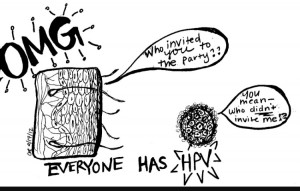Human Papilloma Virus is the most commonly transmitted sexual disease, affecting more than 50% of all sexually active women AND MEN. This blog post attempts to spread the awareness of this potentially cancer causing disease by verifying or debunking common media sources on the virus.
This video on debunking common myths is about popular misconceptions and questions about the disease. It claims:
- HPV affects 80% of all women by age 50→While this exact percent can not be verified, it is true that at least 50% of all sexually active women and men are affected.
- HPV is the most common STD→TRUE
- Is HPV curable? Or is the disease lifelong? This new clip claims the virus is not curable and certain types may remain dormant in the body for life.→ TRUE. Also, the outcome of cancer related to HPV could be a potentially lifelong condition.
- It only takes 1 sexual encounter to contract HPV, it is not a disease favorable towards promiscuous people.→ TRUE. Skin-to-skin contact could be another possible route of transmission.
- There are 100 different subtypes of HPV and most present asymptomatic (showing no signs or symptoms). →TRUE. A person could have contracted one of the many types of this virus and not even know it.
- Complete protection is only guaranteed through full abstinence-including no skin-to-skin contact. Other methods of prevention are delaying age of onset of sexual activity, limiting the number of sexual partners one has, and getting the HPV vaccine.→TRUE.
- While there is no cure, there are treatment options available for certain manifestations, such as genital warts, including creams and laser treatments.→TRUE
- Men are vectors (transmitters) of the virus. →FALSE, transmission is equal in both men and women.
- Cancers, such as penile, anas, and vulvar cancer can be caused by human papilloma virus, and this usually occurs in men.→TRUE, men are more at risk for contracting cancer related to HPV. Although females can get cervical cancer from certain types of high risk HPV.
This video on HPV and men attempts to let it be known that women are not the only ones at risk, men can have fatal consequences too. Fact versus fiction:
- Absence of signs and symptoms associated with HPV occurs more in males than females.→TRUE
- 100 different types of HPV exist, including low risk types which cause genital warts, and high risk types which are associated with certain cancers.→TRUE
- Men are 3x more likely to get head/neck cancers from HPV than women are.→TRUE, also Oral HPV Disease is 3x more prevalent in males than females.
- There is no screening for men, only screenings for certain manifestations such as anal cancer. →TRUE.
- Men who have sex with men are at a higher risk for HPV →TRUE, gays, bisexuals, and immunocompromised individuals are at a higher risk.
- Full proof prevention is obtained through abstinence and condoms provide some degree of protection.→TRUE
- Males ages 9-26 are recommended to get the vaccine which protects against the 2 most prevalent low risk types, and 2 high risk types which can cause cancer. The complete series of shots must be administered to receive the full protection of the vaccine. →TRUE
Finally this possible vaccine gone wrong, might make you question your method of prevention.
- Cervical cancer, which can be caused by HPV, is the 2nd most prevalent cancer in the US, second to breast cancer, for women under the age of 35.→TRUE
- Side effects of the vaccine can include fever, muscle aches, back and neck aches, chronic nausea and loss of strength in hands and legs.→TRUE, but it is important to add these are RARE side effects that must be reported in order to properly inform the public but the chances and occurrence of these side effects occurring are extremely low.
- There is little known about HPV, the vaccine and its potential side effects.→FALSE. The Center for Disease Control puts vaccines through a rigorous amount of tests and trials, so if the vaccine is CDC approved-there is much known about the condition and it is safe to receive the vaccine.
- In an effort to defend itself, the government claimed the side effects experienced by this particular patient can not be proven to have come from the vaccine.→TRUE, it can not be definitely stated.
In conclusion, if you are cautious about what media sources you expose yourself to, they can be trusted. Use your judgement, a youtube video shot by a non professional person might not be the most reliable source, while a new clip would probably contain accurate info.

